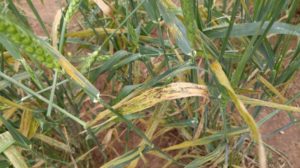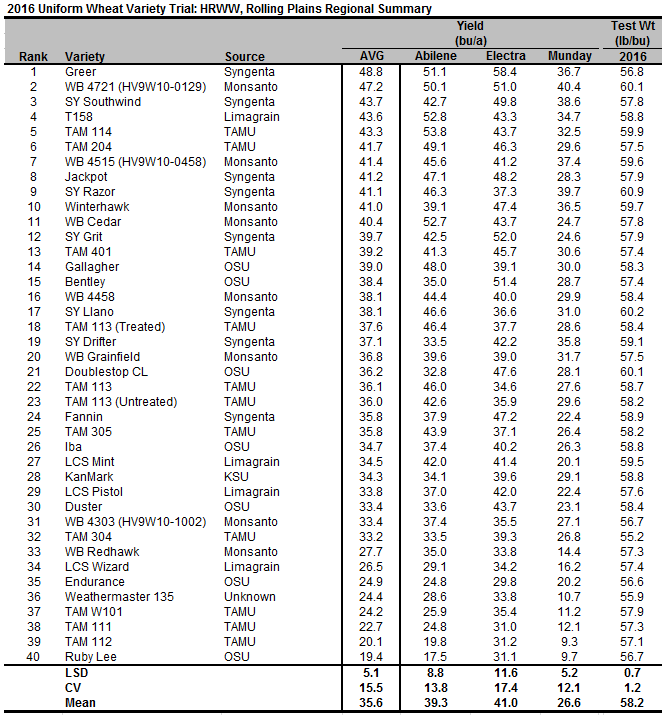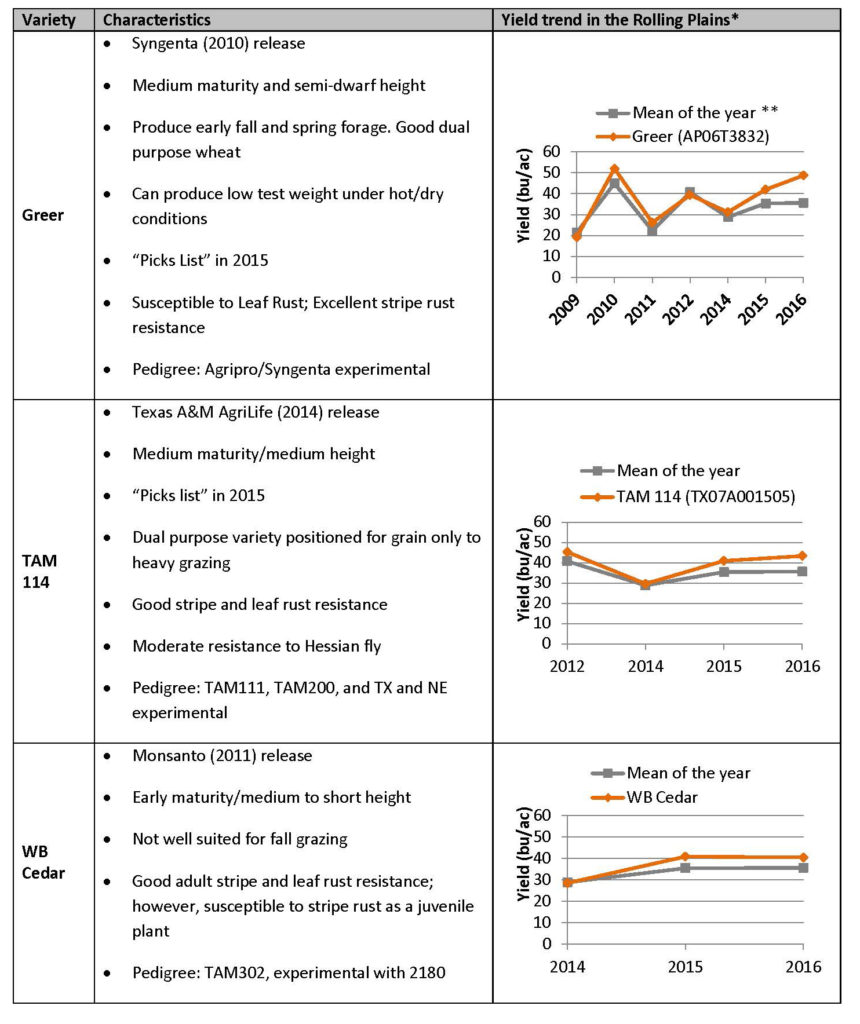by Emi Kimura, Extension Specialist, Vernon, TX and Clark Neely, Small Grains Specialist, College Station, TX
Variety selection is one of the most important decision that a producer needs to make before planting because it will affect yield, test weight, grain quality, and control of weeds, diseases, and insects. Therefore, unbiased and replicated variety trial results are critical to provide wheat producers comparative information of wheat varieties best suited for their wheat production region. The Uniform Wheat Variety Trial is a collaborative effort among AgriLife Research and Extension. We appreciate the cooperation from Texas A&M AgriLife County Extension Agents, producer cooperators, and private industry groups that contribute time, property, and seed to conduct these field trials. Trials are funded by Texas Wheat Producer Board. We greatly appreciate your contribution through check-off dollars!
2016 Results for the Rolling Plains
Four Uniform Wheat Variety Trials were established at Electra, Chillicothe, Munday, and Abilene, of which Chillicothe site was abandoned due to hail damage during the end of May. Please see Table 1 for the background information of trials.
Table 1. 2016 Uniform Wheat Variety Trial: Rolling Plains background information
| Cooperator | Irri/dry | Plant | Harv. | Duration (Days) |
Precipitation (Sep-May) |
Heat unit (°F) | |
| Electra | Carl Brockreide | Dry | 11/13 | 6/8 | 208 | 18.2″ | 4877 |
| Munday | Kenneth Baker | Dry | 11/12 | 6/9 | 210 | 14.8″ | 5302 |
| Abilene | Danny Lewis | Dry | 12/10 | 6/9 | 182 | 24.5″ | 4797 |
All trials in the Rolling Plains were conducted under rain fed condition. Electra received average precipitation for the region during September 2015 to May 2016, while the Munday site received 5” less than long-term average precipitation. Abilene site received 12.5” higher than long-term average precipitation (Table 1). Wheat planting was delayed across the Rolling Plains due to the concentrated rain in October 2015. Stripe rust started earlier than expected in late-January to early-February (Photo 1). Continuous field scouting and timely spraying can make a significant difference in yield and test weight for wheat grown in the Rolling Plains. For the latest fungicide list, please visit “Fungicides labeled for wheat for the control of rusts in Texas: 2016”.
Table 2 summarizes wheat variety trial result in the Rolling Plains of Texas for the 2015-2016 crop year. Our five highest yielding wheat varieties for the 2015-2016 crop year were Greer (48.8 bu/a), WB 4721 (47.2 bu/a), SY Southwind (43.7 bu/a), T158 (43.6 bu/a), and TAM114 (43.3 bu/a).
Table 2. 2016 Uniform Wheat Variety Trial: Rolling Plains Regional Summary
Picks list for 2016-2017 crop year
Based on 2016 and past results, wheat Picks list was selected for the 2016-2017 crop year for the Rolling Plains of Texas. Our ongoing Picks criteria include a minimum of three years of data in Texas A&M AgriLife Rolling Plains wheat variety dryland trials across multiple annual locations. A “Pick” variety means this: given the data, these are the varieties we would choose to include and emphasize on our farm for wheat grain production. Picks are not necessarily the numerical top yielders as important disease resistance traits (leaf, stripe, and stem rust), insect tolerance (greenbugs, Russian wheat aphid), or standability can also be important varietal traits that enable a producer to better manage potential risk. We look for consistency of yields, e.g. the regularity with which an individual variety is in the top 25% of yield at each location.
Table 1. Picks list for 2016-2017 crop year for the Rolling Plains of Texas.
| Picks List | Source | 3 Years Avg.* | 2016 Avg.* | |
| Bu/ac | ||||
| 1 | Greer | Syngenta | 40.7 | 48.8 |
| 2 | TAM 114 | Texas A&M | 37.9 | 43.3 |
| 3 | WB Cedar | Monsanto | 36.6 | 40.4 |
| 4 | Gallagher | Oklahoma St. | 34.9 | 39.0 |
| 5 | WB 4458 | Monsanto | 38.2 | 38.1 |
| 6 | TAM 304 | Texas A&M | 33.6 | 33.2 |
*Yields are obtained only from dryland trials
Table 2 summarizes characteristics and yield trends of Picks list varieties for the Rolling Plains. The yield trend figure on the right column was generated from dryland wheat variety trial data over the past years in the Rolling Plains. It can be interpreted in such a way that if an orange line is above gray line in a given year, it indicates that yield of the variety for the particular year is above average. If orange line is consistently above gray line across multiple years, it means the variety performs consistently well and is adapted to the environment in the Rolling Plains. It is important to pay attention to the yield response of each variety for multiple years rather than single year.
Table 2. Variety characteristics and yield trend from past trials.
*Yield trend was generated from average yield of dryland trials across the Rolling Plains
**Mean of the year indicates an average yield of all 40 varieties entered into the trial for the year
Please visit “In-Blog” Wheat Field Day in Texas Rolling Plains Agronomy Program Blog” for photos of each variety taken during growing season in the Rolling Plains.
The information given herein is for educational purposes only. Reference to commercial products or trade names is made with the understanding that no discrimination is intended and no endorsement by the Texas A&M AgriLife Extension Service is implied.





